Victorian shoes: 1800s
Before the mass production of shoes, towns like King's Lynn had their own craftsmen who made and mended boots and shoes.
'White's Norfolk Directory' of 1845 lists 67 boot and shoemakers trading in King's Lynn supplying the needs of its 20,000 townspeople.

By 1896 there were still 38 boot and shoemakers working in the town. But by then, centres such as Norwich and Northampton were producing shoes in factories using industrial processes.
Timeline
1250 - 1799
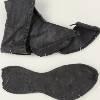
Early shoes - The earliest surviving King's Lynn shoes date back to about 1250. Archaeologists excavating in King's Lynn in the 1960s found well preserved remains of leather shoes almost everywhere they dug.
1800s

Victorian shoes - Before the mass production of shoes, towns like King's Lynn had their own craftsmen who made and mended boots and shoes. 'White's Norfolk Directory' of 1845 lists 67 boot and shoemakers trading in King's Lynn.
1920s
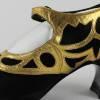
Walking jewellery - The most popular style of footwear was the bar shoe. It had a simple design with a heel, single strap and button to fasten. Shoes were made from satin, brightly coloured leathers and exotic skins.
1930s
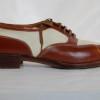
Ready-to-wear - During this period the look of the High Street changed. Department stores such as Marks and Spencer and Burtons the Tailor opened shops in King's Lynn. Local, well established, independent retailers continued to trade.
1940s
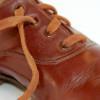
Footwear during the war years - On the Home Front clothing was practical. People were encouraged to 'make do and mend' - modifying the clothing that they already had. Shoe polish wasn't available so people were encouraged to use a cut potato to shine their shoes.
1950s
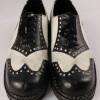
Fun and fashion - During the 1950s young people had more disposable income resulting in a development of youth fashion. These thick crepe-sole shoes are commonly known as creepers. Local cobblers began to refine the creeper to include larger soles.
1960s
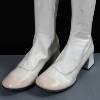
Shoes a-go-go - Local cobblers began to refine the creeper to include larger soles. Go-go boots may have been named after go-go dancing in nightclubs.
1970s
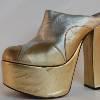
A platform for shoes - In the early 1970s popular fashion and lifestyle magazine 'Vogue' declared "there are no rules in the fashion game now." Disco music inspired many fashions of the late 1970s.
Modern day

High tech and the high street - Specialist sport shoe manufacturers are now using cutting-edge technology to enhance the user's performance. These new developments are changing what a shoe is, and what a shoe can do for its wearer.





